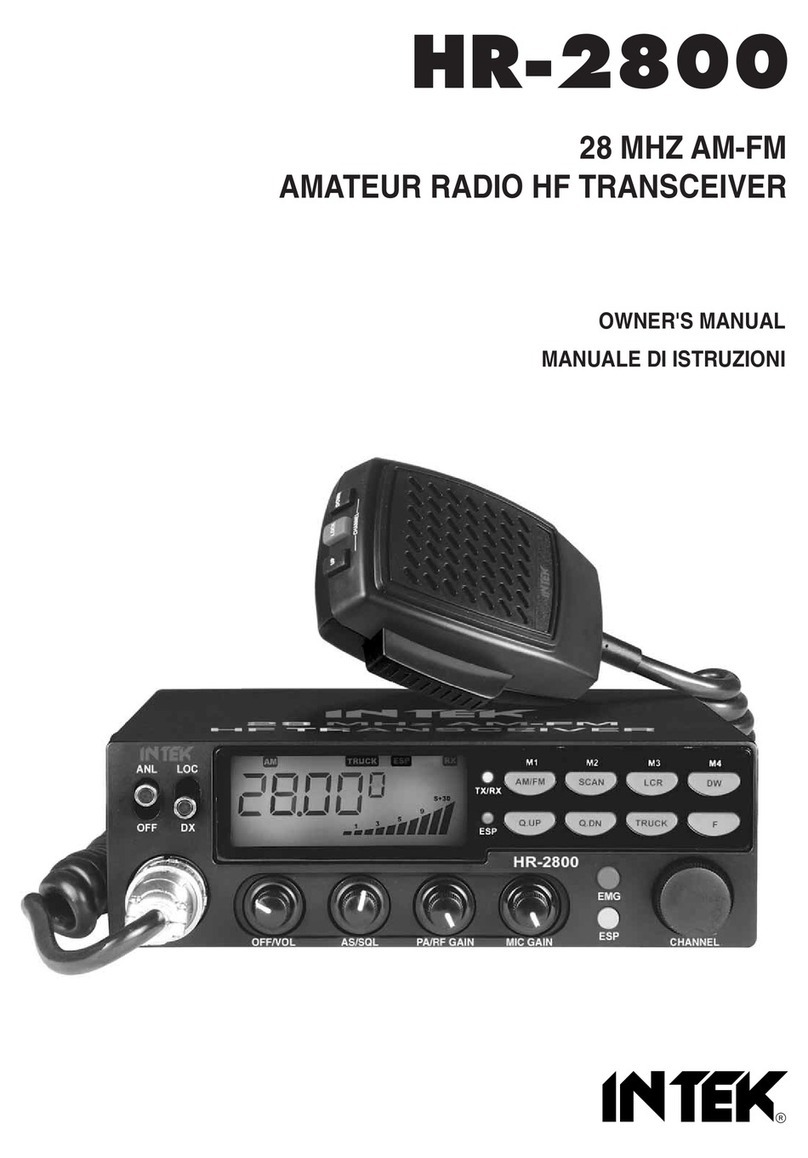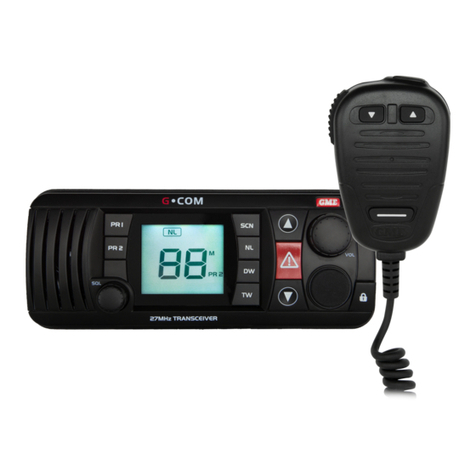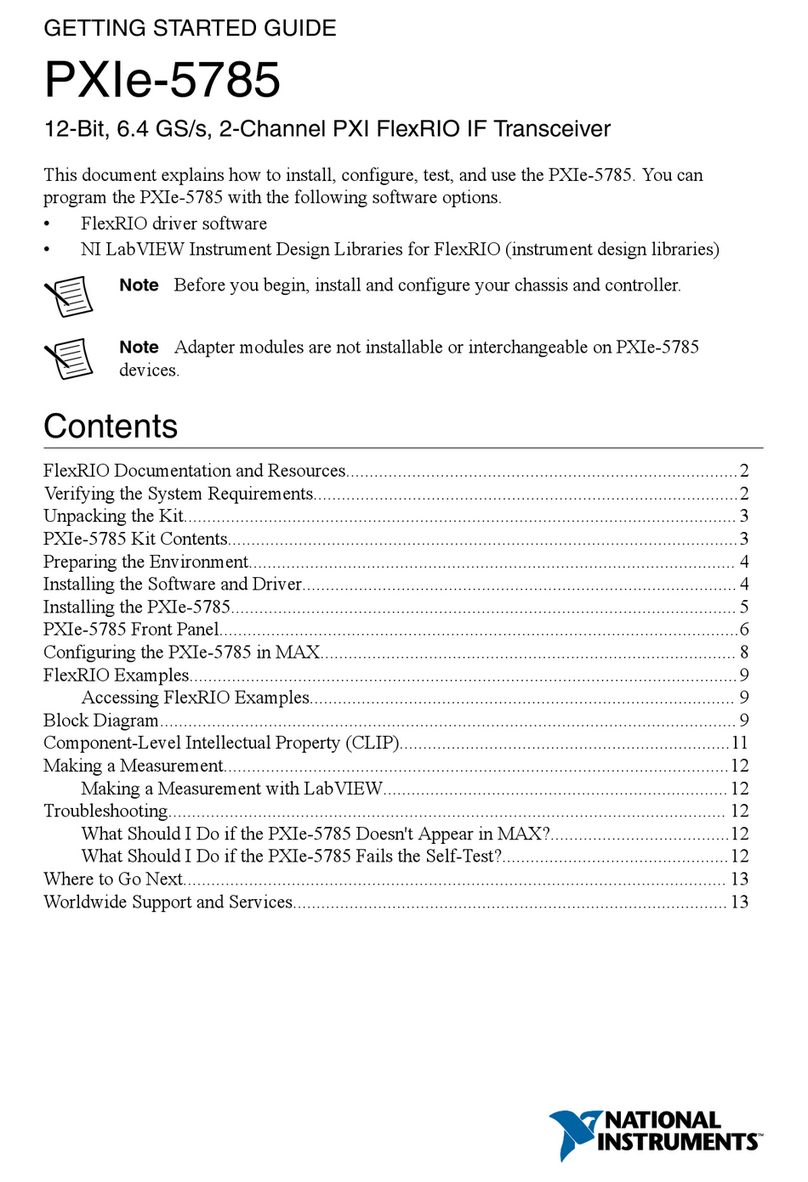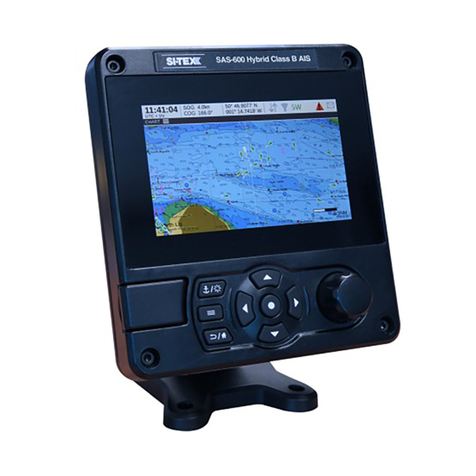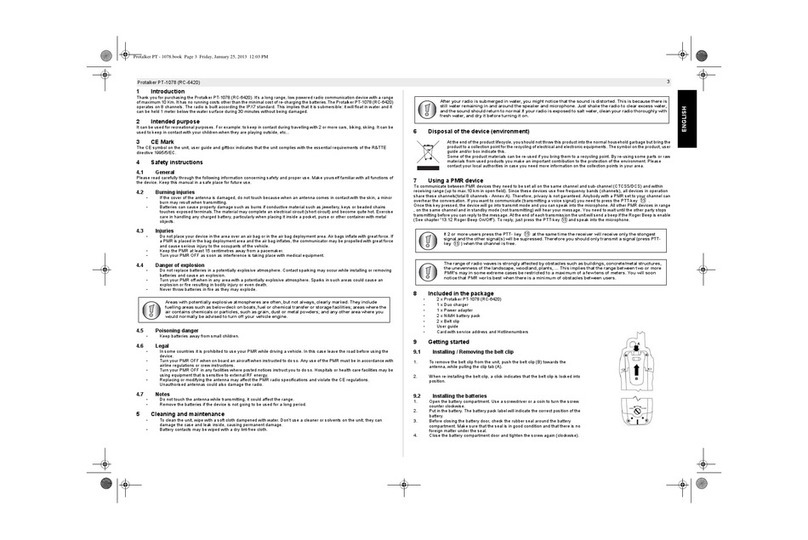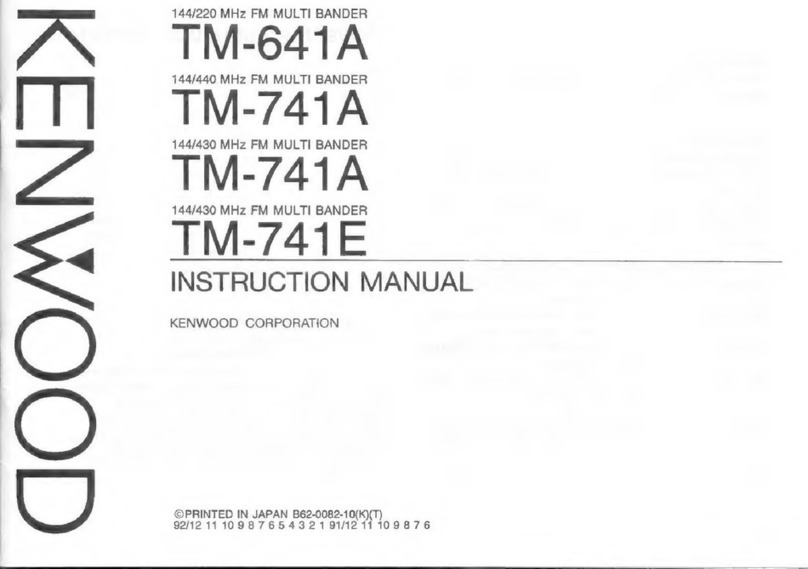SEA 7157 User manual

SEA 7157 OPERATOR’S MANUAL
25W VHF/DSC RADIOTELEPHONE
Software Version:
Ver. 1.10 11, Feb 1999


TABLE OF CONTENTS
GENERAL OPERATIONS...............................................................................1
Technical Specifications...................................................................................1
General Information .........................................................................................2
LCD Display Characters...................................................................................3
Front Panel Controls.........................................................................................3
Basic Operation................................................................................................4
Turning The Radio ON.....................................................................................5
Selecting A Channel List..................................................................................5
Selecting A Channel.........................................................................................6
Adjusting The Squelch .....................................................................................6
Channel 16 Key................................................................................................7
Operating The Transmitter ...............................................................................7
ADVANCED RADIO OPERATIONS..............................................................8
Selecting The Radio Menu ...............................................................................8
Changing The Transmit Power Level...............................................................8
LCD Contrast Adjustment................................................................................9
Dimming The Backlighting ..............................................................................9
Receiver Sensitivity..........................................................................................9
Changing The Priority Channel........................................................................9
Assigning MEM Channels For Scanning........................................................10
Dual Watch Scan............................................................................................10
Search Scan ....................................................................................................11
Memory Scan..................................................................................................11
Scan Options...................................................................................................12
Reviewing Memory Channels.........................................................................12
Adjusting The Scan Hang Time......................................................................13
Clearing The Radio Memory..........................................................................13
Changing The Beep........................................................................................13
Naming A Channel .........................................................................................14
Checking The Software Version.....................................................................14
DSC OPERATIONS.........................................................................................15
DSC Distress Calling......................................................................................15
Selecting The DSC Menu...............................................................................16
Routine Individual DSC Calls ........................................................................17
DSC Calls Using Alternate Calling Channel ..................................................17
DSC Distress Relay Calls...............................................................................18
All Ships DSC Calls .......................................................................................18
Placing A Telephone Call With DSC.............................................................19
Receiving A DSC Call....................................................................................19
Reviewing The DSC Call Logs.......................................................................20

TABLE OF CONTENTS
GMDSS CLASS A CALLS..............................................................................21
Details Of A “Class A” Call...........................................................................21
Distress Call....................................................................................................24
All Ships Calls................................................................................................25
Geographical Area Calls.................................................................................26
Individual / Group Calls.................................................................................27
Phone Calls.....................................................................................................28
PROGRAMMING DSC OPTIONS................................................................29
DSC Programming..........................................................................................29
Setting The Date & Time................................................................................29
Programming The DSC ID (MMSI)...............................................................30
Programming The Navigation Interface .........................................................30
Programming Options.....................................................................................31
Using Test And Diagnostic Utilities...............................................................32
Programming The DSC Directory..................................................................32
Programming The Telephone Directory.........................................................33
Inputting Position Data...................................................................................34
FREQUENCY LISTINGS...............................................................................35
USA Channel List...........................................................................................35
Amended International List ............................................................................36
International Channel List ..............................................................................37
Weather Channel List.....................................................................................38
REAR PANEL..................................................................................................39
Rear Panel Connections..................................................................................39
GLOSSARY......................................................................................................41


GENERAL OPERATIONS
1
TECHNICAL SPECIFICATIONS
DIMENSIONS:
3.9” H x 10.5” W x 10.9” D
99mm H x 265mm W x 278mm D
WEIGHT:
7.75 Lbs.
3.5 Kgs.
ELECTRICAL:
Type Acceptance FCC Parts 80, 15
GMDSS (Para 80.1101)
EIA RS-204C, RS-152B
FCC Identifier BZ6SEA7157
Frequency Range (TX) 155 - 159 MHz
(RX) 155 - 163.6 MHz
Operating Temperature -30 degrees to +60 degrees C
Frequency Stability ±5 ppm
Emission 16K0G3E, 13K5G2B
Primary Voltage 12 or 24 VDC +30%, -10%
Floating Chassis
Current Drain 12 Volts Receive Standby 0.5 Amp
Receive Full Audio 1.0 Amps
Max TX: (25W) 4.5 Amps
(1W) 1.0 Amp
24 Volts Receive Standby 0.3 Amp
Receive Full Audio 0.5 Amps
Max TX: (25W) 2.35 Amps
(1W) 0.80 Amp
Output Impedance 50 ohms
Transmitter Output Power 25W, 1W
Frequency Deviation 5 KHz maximum peak
Receiver Sensitivity ≤0.3 µV for 12 dB SINAD
Audio Output 4 W @ ≤10% distortion into external
4 ohm load. 2 W internal
Channel 70 Receiver Sensitivity ≤1 µV for 20 dB SINAD
DSC Facility ≤1 µV for 10-2 B.E.R.

GENERAL OPERATIONS
2
GENERAL INFORMATION
CAUTION !
Do not attempt to transmit until the radiotelephone has warmed up for at least 30
seconds. Transmitting before the 30 second warm up period may cause a
violation of the Federal Communications Commission regulations.
PROPAGATION
Very High Frequencies (VHF) in the range of 30 MHz to 300 MHz may travel
far beyond the horizon under ideal conditions. For reliable communications,
VHF transmissions should be limited to no more than 30 miles.
INSTALLATION (RF grounding & DC connections)
The SEA 7157 may be configured to operate from either 12 or 24 volts DC
(direct current). Check the rear panel of the radio to determine the proper
operating voltage required. A direct connection to the power source is
recommended. Proper wire size must be used between the radio and power
source to prevent the DC voltage at the radio from dropping below 10.8 or 21.6
volts during transmit conditions. Should this occur, the radio may produce
distorted transmissions. Connect the RED positive (+) lead from the radio to the
positive supply terminal. The BLACK negative (-) power lead should connect to
the negative supply terminal. A #10 ground stud is provided for connecting the
radio chassis to the ship’s earth connection with a copper strap.
The SEA 7157 is equipped with two UHF type RF connectors for the
installation of two independent antennas. One antenna allows constant
monitoring of the DSC channel while the other antenna labeled “ANTENNA 50
OHMS” is used for normal radio operations. The nominal impedance of each
antenna is 50Ωwhich requires high quality RG-213/U or equivalent coax.
It is recommended that an authorized SEA dealer perform the installation of your
VHF equipment to assure proper operation. For complete installation
instructions, refer to the “SEA 7157 Installation Manual” (OPR-7157-INST)
supplied with the radio.
RADIO PROTECTION
The chassis of the SEA 7157 is not connected to either supply rail. This allows a
direct connection to the ship’s earth connection for voltage and RF interference
protection. In the event that the input voltage is reversed, the line fuse (7.5 amp
for 12 volt operation or 5 amp for 24 volt operation) will blow. It is also likely
that the internal reverse polarity protection diode CR20 will be damaged in order
to protect the remaining circuitry. Overvoltage to the radio will cause similar
results. If this should occur and a replacement fuse also blows, an authorized
SEA dealer should be contacted for proper service repairs.

GENERAL OPERATIONS
3
LCD DISPLAY CHARACTERS
The radio is in TRANSMIT.
Indicates the radio will transmit using 25 watts of output power.
Indicates the radio will transmit using 1 watt of output power.
The radio is set for maximum receive sensitivity.
The radio is set for local receive sensitivity.
Displayed channel is the priority channel.
Changes to bold font when adjusting the SQUELCH threshold.
Indicates US channel list is enabled.
Indicates International channel list is enabled.
Indicates Weather channel list is enabled.
Indicates the displayed channel is US simplex.
FRONT PANEL CONTROLS
Toggles channel selection between priority channel and CH 16.
Allows entry of channel selection, alphanumeric channel
information and menu selections.
Initiates an Emergency DSC call.
Selects DSC operations.
Toggles between radio menu selections and normal operations.
Aborts DSC operations.
Allows quick access to squelch settings for normal operations.
Selects print feature in other modes.
Selects US, INT or WX channel list. Also serves as a backspace
key when used for alphanumeric entry or selects previous menu.
Selects displayed function or completes keyed entry .
Increases squelch, channel, alphanumeric and contrast settings.
Also scrolls through DSC memory logs.
Decreases squelch, channel, alphanumeric and contrast settings.
Also scrolls through DSC memory logs.
TX
25W
1W
DX
PRI
SQL
US
INT
WX
A
0 – 9
16
DISTRESS
RADIO
SQL
DSC
LIST
←BKSP
LOC
ENT
DN
UP

GENERAL OPERATIONS
4
UP
DN
BASIC OPERATION
To turn the radio on, rotate the volume control
clockwise until a click is heard.
Rotating the volume control
clockwise after the click is
heard will increase the volume level.
Rotate the volume control fully counter
clockwise to turn the radio off.
Press the key followed by the
or key to adjust the squelch threshold.
Press the or key to stop
squelch adjustment.
Enter the desired channel number in one, two
or three digit form, followed by the
key.
e.g.
Your SEA 7157 is now set to transmit and receive on the selected channel.
For instructions on using additional radio functions, see the table of contents for
the page number corresponding to the specific function.
Illustrations in this manual may differ from your own depending on enabled
programming features, selected channel list and differences in display fonts.
ENT
SQL
ENT
6 M
N
O
2 A
B
C
C. SEA Inc., 1999
A UNIT OF DATAMARINE
Ver 1.10 11 FEB 1999
SEA 7157 VHF / DSC
RADIOTELEPHONE
UP
DN
DISTRESS DSC SQL 16
RADIO
ENT
2
A
B
C3 D
E
F
4 G
H
I5 J
K
L6 M
N
O
7 P
R
S8 T
U
V9 W
X
Y
0 Q
Z
LIST
←BKSP
1SP
C. SEA Inc.
,
1999
A UNIT OF DATAMARINE
Ver 1.10 11 FEB 1999
PRESS UP/DOWN
2:43 47° 47N 122° 19W
16DX
25W US
PRI
SQL
TO ADJUST SQL
PUBLIC CORR
2:43 47° 47N 122° 19W
26DX
25W US
SQL
ENT
RADIO

GENERAL OPERATIONS
5
TURNING THE RADIO ON
Rotate the volume control clockwise until a
click is heard.
A checkerboard display
will be shown for a short period followed by
the software version. The radio will be set to
the last selected channel and squelch setting
saved in memory.
Rotating the volume control clockwise beyond
the click will increase the volume level.
When the radio is turned off, all scan routines
are canceled. The current channel, channel list,
and squelch setting will be recalled the next
time power is applied.
SELECTING A CHANNEL LIST
Pressing the key will cycle the radio
through the three available channel lists.
The US channel list contains channel settings
unique to the United States. When selected,
the last used US channel will be recalled.
Pressing the key while in the US list
will cycle the radio to the INT (International)
channel list. The last used INT channel will be
recalled.
Pressing the key while in the INT list
will cycle the radio to the last WX (Weather)
channel used from the WX channel list. Ten
receive only weather channels are available for
receiving current weather conditions in the
local area.
LIST
←BKSP
LIST
←BKSP
LIST
←BKSP
INTERSHIP
2:44 47° 47N 122° 19W
6DX
25W INT
SQL
International list
PUBLIC CORR
2:43 47° 47N 122° 19W
26DX
25W US
SQL
US channel list
WEATHER
2:44 47° 47N 122° 19W
1DX WX
SQL
Weather channel list
C. SEA Inc., 1999
A UNIT OF DATAMARINE
Ver 1.10 11 FEB 1999
Software version number and date
PUBLIC CORR
2:43 47° 47N 122° 19W
26DX
25W US
SQL
Last used channel is recalled at powerup

GENERAL OPERATIONS
6
UP
UP
UP
DN
DN
SELECTING A CHANNEL
Select the channel list containing the required
channel with the key.
The channel may be selected by entering the
channel number directly with the number keys
followed by the key.
Using the and keys will allow the
next or previous channel in the list to be
accessed. When a simplex channel is needed,
enter the closest channel number next to the
desired channel and press the up or down key.
e.g. To select CH 1Afrom the US list, press
the following keys:
repeatedly until the US list appears.
for CH 1.
key to access CH 1A.
ADJUSTING THE SQUELCH
The squelch prevents unwanted noise from
getting through to the speaker. The higher the
squelch setting, the less chance of noise getting
through.
Press the key followed by the
key until noise is heard through the speaker.
Increase the number of squelch bars on the
display by pressing the key until the
noise stops. This is the ideal setting
for the squelch threshold. Pressing either the
or key will stop squelch
adjustment.
In the event that noise occasionally opens the
squelch, increase the number of squelch bars on
the display by one or two .
Adjusting the squelch threshold too high may
cause desired signals to be missed.
LIST
←BKSP
ENT
LIST
←BKSP
ENT
ENT
SQL
1 SP
PUBLIC CORR
2:45 47° 47N 122° 19W
26DX
25W US
SQL
Low squelch setting
PRESS UP/DOWN
2:45 47° 47N 122° 19W
26DX
25W US
SQL
TO ADJUST SQL
Ideal squelch setting
PRESS UP/DOWN
2:46 47° 47N 122° 19W
26DX
25W US
SQL
TO ADJUST SQL
RADIO
PORT OPERS
2:44 47° 47N 122° 19W
1DX
25W
A
US
SQL
Use the UP key to access US CH 1A
2:44 47° 47N 122° 19W
1DX
25W US
SQL
US CH 1
PUBLIC CORR
2:44 47° 47N 122° 19W
26DX
25W US
SQL
Select the proper channel list

GENERAL OPERATIONS
7
UP
CHANNEL 16 KEY
Channel 16 is used as a calling channel and as
an international emergency channel. Channel
16 should be monitored when the radio is not
being used for other communications.
Do not use this channel for ordinary communications.
Pressing the key will set the radio to full output power and abort all
other functions. Pressing the key a second time will switch the radio to the
programmed priority channel. When channel 16 is programmed to be the
priority channel (factory default), switching between channel 16 and the priority
channel will produce no noticeable change.
OPERATING THE TRANSMITTER
Keying the microphone push-to-talk button will
switch the transmitter circuits on, indicated by
the ‘TX’ indicator appearing on the display.
Speak in a normal voice with your lips about
one eighth of an inch away from the
microphone. Do not shout. Shouting reduces
intelligibility.
If regulations prohibit 25 watts of power on a given channel, the power level
cannot be changed. No power level selection is allowed on receive only
channels (e.g. WX channels).
US channels 13, 67, and 77 can be operated at full power by pressing the
key during transmission. Releasing the key will return the radio to 1 watt
operation.
A time out timer is provided to prevent continuous transmissions for periods
greater than 5 minutes. In the event that the radio will be needed to transmit for
periods longer than 5 minutes, it will be necessary to release the PTT briefly
before the 5 minute timer expires.
16
CALL DISTRS
2:46 47° 47N 122° 19W
16DX
25W US
PRI
SQL
Instant recall of CH 16 and Priority channel
PUBLIC CORR
2:46 47° 47N 122° 19W
26TX
25W US
SQL
Display showing transmit condition

ADVANCED RADIO OPERATIONS
8
UP
SELECTING THE RADIO MENU
Several advanced radio options are accessed by
pressing the key.
The most commonly used functions will be
displayed in the first menu. The second menu
is accessed by pressing .
Pressing the key at any time will
abort the menu selection and the radio will
return to normal operations.
CHANGING THE TRANSMIT POWER LEVEL
The transmit power level may be changed
between 1 and 25 watts. The display will show
the current setting while the menu selection
shows what the power level will become.
e.g. To change between high (25W) and low
(1W) power levels:
Press to toggle the power
level.
If regulations prohibit 25 watts of power on a
given channel, the power level cannot be
changed. No power level selection is allowed
on receive only channels (e.g. WX channels).
USA channels 13, 67, and 77 may be operated
at full power by pressing the key during
transmission. Releasing the key will
return the radio to 1 watt operation.
When communicating short distances, it is
recommended that the 1 watt level be used to
help prevent interference with other stations.
1 SP
RADIO
RADIO
RADIO 4 G
H
I
2:47 47° 47N 122° 19W
16DX
25W US
PRI
1=PREV
4=RVW
7=BEEP
2=SRMD 3=SCMD
5=CLR 6=HNG
8=NAME 9=VER
Channel 16 at 25 watt power setting
CALL DISTRS
2:47 47° 47N 122° 19W
16DX
25W US
PRI
SQL
Channel 16 at 1 watt power setting
CALL DISTRS
2:47 47° 47N 122° 19W
16DX
1W US
PRI
SQL
Channel 13 at 25 watts while UP key is pressed
BRG TO BRG
2:47 47° 47N 122° 19W
13TX
25W US
SQL
2:47 47° 47N 122° 19W
16DX
25W US
PRI
1=MORE
4=1W
7=MEM
2=DW 3=SRCH
5=DIM 6=LOC
8=SCAN 9=PRI
Changing CH 16 from 25W to 1W
2:47 47° 47N 122° 19W
16DX
25W US
PRI
1=MORE
4=1W
7=MEM
2=DW 3=SRCH
5=DIM 6=LOC
8=SCAN 9=PRI
Primary Radio menu selections
Secondary Radio menu selections

ADVANCED RADIO OPERATIONS
9
UP DN
LCD CONTRAST ADJUSTMENT
The display’s contrast setting may need to be
adjusted to compensate for differences in
temperature and viewing angle.
To change the contrast level press
followed by or . The keys may be
held or pressed repeatedly.
Pressing will exit the contrast adjustment.
DIMMING THE BACKLIGHTING
The display and keypad backlighting may be
changed by pressing the keys.
Repeatedly pressing the
key will cycle the backlighting
through the various levels. Pressing
will exit backlighting adjustment.
If the backlighting is set to off, the first keypress will turn the backlighting on to
the lowest level for 5 seconds.
RECEIVER SENSITIVITY
The SEA 7157 receiver sensitivity may be
adjusted for local or distant signals. When
working in harbor, it is best to set the LOC/DX
sensitivity to LOC. A setting for LOC will
reduce the amount of interference caused from
pagers and other communications systems.
To select the receiver sensitivity, press .
CHANGING THE PRIORITY CHANNEL
When it is necessary to Dual Scan (Watch) a
given frequency and the priority channel, it
may be necessary to program the priority
channel to something other than channel 16.
To change the priority channel, select the
channel that will become the priority channel
and press . Press to make the displayed channel the
priority channel.
ENT
RADIO 5 J
K
L
5 J
K
L
RADIO 9 W
X
Y
RADIO
RADIO
2:48 47° 47N 122° 19W
13DX
1W US
PRI
1=MORE
4=1W
7=MEM
2=DW 3=SRCH
5=DIM 6=LOC
8=SCAN 9=PRI
Setting CH 13 to be the priority channel
2:48 47° 47N 122° 19W
16DX
25W US
PRI
1=MORE
4=1W
7=MEM
2=DW 3=SRCH
5=DIM 6=LOC
8=SCAN 9=PRI
Radio 5 changes backlighting
2:47 47° 47N 122° 19W
16DX
25W US
PRI
1=MORE
4=1W
7=MEM
2=DW 3=SRCH
5=DIM 6=LOC
8=SCAN 9=PRI
DX / LOC receive sensitivity
ENT
2:48 47° 47N 122° 19W
16DX
25W US
PRI
1=MORE
4=1W
7=MEM
2=DW 3=SRCH
5=DIM 6=LOC
8=SCAN 9=PRI
Low contrast setting
RADIO 6 M
N
O

ADVANCED RADIO OPERATIONS
10
ASSIGNING MEM CHANNELS FOR SCANNING
Channels may be marked for memory scan
operation. Memory scan will scan only those
channels that are marked as ‘MEM’.
To assign a channel as a MEM channel,
select the channel followed by .
Press to select or deselect the
channel as a memory channel.
Memory channels may not be available
depending on code version and regulations.
DUAL WATCH SCAN
Dual Watch scanning (DW) allows you to scan
between the selected and priority channel. The
channel being received will be displayed in
large numbers while the second channel being
watched will simultaneously be displayed in
small numbers above the ‘SQL’ annunciator.
To dual watch the selected and priority
channel, press .
Receiver monitors selected channel (i.e. 13)
and samples priority channel (usually 16). The
‘PRI’ annunciator will flash at the dual watch
scan interval.
Priority channel traffic will override selected
channel traffic.
If the press-to-talk button on the microphone is
pushed, scan is aborted and the radio transmits
on the non priority channel.
Pressing any key will stop dual watch.
ENT
DUAL WATCH
2:48 47° 47N 122° 19W
13DX
25W US
PRI
16
SQL
Dual Watching Priority channel and CH 13
RADIO 7 P
R
S
BRG TO BRG
2:48 47° 47N 122° 19W
13DX
1W US
SQL
Select channel to Dual Watch
2:48 47° 47N 122° 19W
13DX
1W US
1=MORE
4=1W
7=MEM
2=DW 3=SRCH
5=DIM 6=LOC
8=SCAN 9=PRI
Starting Dual Watch Scan
2:48 47° 47N 122° 19W
6DX
25W US
MEM
1=MORE
4=1W
7=MEM
2=DW 3=SRCH
5=DIM 6=LOC
8=SCAN 9=PRI
RADIO 2 A
B
C
2:48 47° 47N 122° 19W
6DX
25W US
FEATURE NOT
AVAILABLE
ENT TO CONTINUE

ADVANCED RADIO OPERATIONS
11
UP
UP
DN
DN
SEARCH SCAN
Pressing allows you to scan
every channel in the current channel list.
Search stops when an active channel is
encountered and resumes when the channel
becomes inactive (see SRMD in SCAN
OPTIONS).
Press the key to skip an active channel.
Press the key to lockout an active
channel. Exiting SRCH mode cancels lockouts.
Entering a channel will exit SRCH. If PTT is
pressed, the search function aborts and radio
transmits on the displayed channel.
Search may not be available depending on code version and regulations.
MEMORY SCAN
Memory scan (SCAN) scans all channels that
have been tagged into memory. Memory scan
channels are recognized by MEM showing on
the display when the channel is selected.
To start memory scan press .
If no channels are tagged MEM, scan aborts.
Scanning stops when an active channel is
encountered and resumes when the channel
becomes inactive (see SCMD in SCAN
OPTIONS).
Press the key to momentarily skip an
active channel and continue search.
Press the key to lockout an active channel during the scan session.
Exiting the SCAN mode cancels lockouts. Entering a channel will exit SCAN.
If the microphone PTT is pressed, the search function aborts and the radio
transmits on the displayed channel.
When the priority channel is selected before starting memory scan, the priority
channel will be sampled between each channel. This is known as priority scan.
Memory Scan may not be available for some code versions and regulations.
2:50 47° 47N 122° 19W
14DX
25W US
FEATURE NOT
AVAILABLE
ENT TO CONTINUE
2:50 47° 47N 122° 19W
14DX
25W US
MEM
1=MORE
4=1W
7=MEM
2=DW 3=SRCH
5=DIM 6=LOC
8=SCAN 9=PRI
Starting Memory Scan
RADIO 8 T
U
V
RADIO 3 D
E
F2:49 47° 47N 122° 19W
14DX
25W US
1=MORE
4=1W
7=MEM
2=DW 3=SRCH
5=DIM 6=LOC
8=SCAN 9=PRI
Press radio, 3 to start scanning
2:49 47° 47N 122° 19W
14DX
25W US
FEATURE NOT
AVAILABLE
ENT TO CONTINUE
If available, all channels will be scanned

ADVANCED RADIO OPERATIONS
12
UP
SCAN OPTIONS
The scan options modify how the radio will
react to an active channel when scanning.
Pressing modifies
the way Search Scan operates by allowing
either stop and go or continuous operation.
Stop and go operation, will stop on an active
channel for the duration of the hang period and
then go to the next channel even if the channel
is still active.
Continuous operation, will stop on an active
channel and continue to monitor the channel as
long as it is active. When the channel becomes
inactive, the radio moves to the next channel.
Pressing modifies
the priority scan and Dual Watch scan for
Guard or Normal mode.
Guard mode always receives the priority
channel if it is active (Dual Watch default).
Normal mode stays on the active channel until
it becomes inactive.
Search Options may not be available
depending on code version and regulations.
REVIEWING MEMORY CHANNELS
Memory channels may be reviewed to see
which channels have been assigned as MEM
channels.
Press to enter the
memory channel review mode. Pressing the
key will step to the next memory channel.
Pressing the key will exit the review
mode.
Memory channels may not be available
depending on code version and regulations.
1 SP
RADIO 4 G
H
I
2:51 47° 47N 122° 19W
13DX
1W US
FEATURE NOT
AVAILABLE
ENT TO CONTINUE
2:52 47° 47N 122° 19W
13DX
1W US
MEM
1=PREV
4=RVW
7=BEEP
2=SRMD 3=SCMD
5=CLR 6=HNG
8=NAME 9=VER
2:51 47° 47N 122° 19W
13DX
1W US
1=MORE
4=1W
7=MEM
2=DW 3=SRCH
5=DIM 6=LOC
8=SCAN 9=PRI
Primary Radio menu selections
2:52 47° 47N 122° 19W
13DX
1W US
MEM
FEATURE NOT
AVAILABLE
ENT TO CONTINUE
2:51 47° 47N 122° 19W
13DX
1W US
1=PREV
4=RVW
7=BEEP
2=SRMD 3=SCMD
5=CLR 6=HNG
8=NAME 9=VER
Scan mode options
RADIO 2 A
B
C
1 SP
RADIO 3 D
E
F
1 SP
2:51 47° 47N 122° 19W
13DX
1W US
1=CONTINUOUS
2=STOP AND GO
SRCH MODE=CONTINUOUS
Modifying the search scan mode
ENT

ADVANCED RADIO OPERATIONS
13
ADJUSTING THE SCAN HANG TIME
Hang time is the amount of time the radio stays
on the active channel or the amount of time the
radio stays on the channel after the channel
becomes inactive, before moving to the next
channel. The amount of time the radio hangs
before moving to the next channel can be
changed from ½ second to 4½ seconds in ½
second increments.
Press to adjust hang
time.
Hang time adjustments may not be available
depending on code version and regulations.
CLEARING THE RADIO MEMORY
To clear all channels from the memory scan list
and reset the priority channel to 16, press
.
All settings assigned to the radio functions will
be reset to the default factory settings.
CHANGING THE BEEP
An audible tone will be heard whenever a key is
pressed. The key beep can be turned on or off by
pressing the key followed by the
key.
Press to toggle the beep control setting.
1 SP
2:53 47° 47N 122° 19W
13DX
1W US
FEATURE NOT
AVAILABLE
ENT TO CONTINUE
RADIO
RADIO
5 J
K
L
7 P
R
S
2:53 47° 47N 122° 19W
16DX
25W US
PRI
1=PREV
4=RVW
7=BEEP
2=SRMD 3=SCMD
5=CLR 6=HNG
8=NAME 9=VER
Resetting radio functions to factory default
1 SP
RADIO 6 M
N
O
1 SP
2:53 47° 47N 122° 19W
13DX
1W US
1=PREV
4=RVW
7=BEEP
2=SRMD 3=SCMD
5=CLR 6=HNG
8=NAME 9=VER
Radio menu for hang time adjustment
2:53 47° 47N 122° 19W
16DX
25W US
PRI
1=PREV
4=RVW
7=BEEP
2=SRMD 3=SCMD
5=CLR 6=HNG
8=NAME 9=VER
Toggle key beep ON / OFF

ADVANCED RADIO OPERATIONS
14
UP DN
NAMING A CHANNEL
In the normal radio display an 11 character
alphanumeric name is shown below the channel
number. In some displays, the name is truncated
to 5 characters.
To modify the name, press the key
followed by the key to access the radio
menu.
Press the key to modify the name of the
displayed channel. A cursor will appear at the
end of the highlighted name. Pressing any key
other than will overwrite the entire
name. Pressing the will backspace over
and erase the last character.
Use the alphanumeric keys to enter letters and
digits. The and keys will
cycle through the characters on the key. When
the desired channel name has been entered, press
to return to normal radio operations.
CHECKING THE SOFTWARE VERSION
The radio’s software version is shown on the
display at power up. A more detailed version
check may be displayed by pressing the
key followed by and .
The version number, release date, serial number
and checksum will be shown on the first screen.
This information can be helpful in determining
what options are available in the radio.
If the key is pressed within 1 minute,
the second screen will show the DSC ID and
Group DSC ID currently programmed.
Pressing the key or waiting 1 minute
will return the radio to normal operations.
ENT
8 T
U
V
LIST
←BKSP
GRPID: 111222333
DSCID: 123456789
PRESS ENT TO EXIT
CHECKSUM: 2D73
SERNO: ES00004
11 FEB 1999
7157 VER 1.10
PRESS ENT FOR MORE
2:54 47° 47N 122° 19W
16DX
25W US
PRI
1=PREV
4=RVW
7=BEEP
2=SRMD 3=SCMD
5=CLR 6=HNG
8=NAME 9=VER
RADIO
1 SP
RADIO
1 SP 9 W
X
Y
ENT
ENT
LIST
←BKSP
2:53 47° 47N 122° 19W
16DX
25W US
PRI
1=PREV
4=RVW
7=BEEP
2=SRMD 3=SCMD
5=CLR 6=HNG
8=NAME 9=VER
Radio menu to rename channel
BRG TO BRG
2:54 47° 47N 122° 19W
13DX
1W US
SQL
Normal radio display with named channel
2:54 47° 47N 122° 19W
1=REVIEW
3=DSC
5=RELAY
7=PHONE
13 US BRG T
8=CLASS A
2=PROGRAM
4=ALT CHAN
6=ALL SHIP
DSC display with named channel

DSC OPERATIONS
15
UP
DSC DISTRESS CALLING
A distress DSC call can be transmitted by using
the following method.
When equipped with a protective cover, lift the
cover to expose the key.
Press and hold the key for 5 seconds.
An alert tone will sound while the key is held.
Select from the list of available distress
conditions shown. If the condition is not
shown, press the key for more selections.
After selecting the type of distress, press the
key to transmit the DSC emergency.
If the radio is not supplied with positioning
information from a LORAN or GPS, follow the
prompts to input a Lat/Long position.
After entering the position manually and
pressing the key, you are prompted to
press the key to transmit the DSC
emergency on DSC channel 70.
The radio will wait for an acknowledgment
from the coast station and automatically resend
the DSC emergency approximately every 4
minutes if a coast station does not respond.
You may press the key to resend the
emergency again or press the key to
exit the DSC emergency.
2:55 47° 47N 122° 19W
1=NONE
3=FLOOD
5=GROUND
7=SINKING
1US EXAMP
A
UP=MORE
2=FIRE
4=COLLIDE
6=LISTING
DISTRESS
2:55 NO-NAV-DATA
QUADRANT:
LATITUDE:
LONGITUDE:
MINUTES
(
0-59’
)
:
1US EXAMP
A
NW
47° 47’
122° 19
FOR DISTRESS
HOLD 5 SECONDS
ENT
DISTRESS
2:55 47° 47N 122° 19W
1=ADRIFT
3=PIRACY
5=EPIRB
1US EXAMP
A
UP=MORE
2=ABANDON
4=MANOVER
DSC
2:56 47° 47N 122° 19W
REPEAT IN 4:29
WAITING FOR ACK
PRESS DSC TO RESEND
PRESS RADIO TO EXIT
1US EXAMP
A
2:55 47° 47N 122° 19W
PRESS DSC TO XMT
1US EXAMP
A
2:55 NO-NAV-DATA
ENTER POS MANUALLY?
1=YES 2=NO <1
1US EXAMP
A
DSC
2:55 NO-NAV-DATA
SELECT QUADRANT
0=NE
2=SE
1US EXAMP
A
1=NW
3=SW
DSC
RADIO
Table of contents
Other SEA Transceiver manuals


